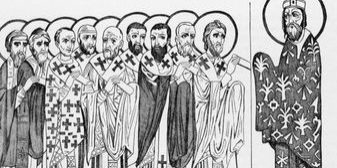
Understanding Orthodoxy
By Nathan Finn
This week marks the beginning of the fall semester at Southeastern Baptist Theological Seminary. This post is adapted from one my early lectures in my Church History I class. Nothing like explaining to several dozen Southern Baptist students that there is great value in the Patristic creedal tradition! If we are going to have an intelligent conversation about church tradition, we have to begin by coming to an intelligent understanding of the nature of orthodoxy in the Early Church.
There is widespread disagreement among historians about the best way to account for the progress of Christian orthodoxy during the Patristic Era. There are at least four different options, only two of which seem to be valid positions for evangelical historians and theologians.
1. Competing orthodoxies
Some historians argue that there was no such thing as orthodoxy before the fourth century. Rather, competing would-be orthodoxies fought with one another until the reign of Constantine, when one faction finally won and condemned all the losers as heretics. According to this view, orthodoxy is more about political success than correct doctrine. It also assumes that heresy is just as valid as orthodoxy (maybe even more valid).
The competing orthodoxies view is associated with Walter Bauer’s famous book Orthodoxy and Heresy in Earliest Christianity (1934; English translation 1971). In recent years, variations of this position have been championed by scholars such as Bart Ehrman and Elaine Pagels and popularized by The DaVinci Code.
2. Evolutionary orthodoxy
Other historians argue that there is a difference between the simple faith of the New Testament and later orthodoxy. According to this view, Jesus preached the kingdom ethic of loving God and neighbor, but later theologians distorted this message by adding all their doctrines. Most often, Paul is castigated as the chief culprit in beginning the unfortunate move from simple gospel to rigid orthodoxy.
Evolutionary orthodoxy is closely associated with the famous liberal historical theologian Adolf von Harnack in his seven volume History of Dogma (1894–1912). This view became the default position of classical liberalism. Though it is no longer popular with many church historians, it is still found in two places. Many liberal New Testament scholars, such as most of the participants in the Jesus Seminar, advocate a form of evolutionary orthodoxy. A version of this view is also disseminated on a more popular level by some of the Emergent Church leaders, especially Brian McLaren.
Though widely held, the above views are judged spurious by those with a high view of Scripture and/or the church. Conservative/traditionalist scholars counter that orthodoxy is in basic continuity with the teachings of the Scriptures and the best of church tradition. For this reason, we reject the first two options because of the former’s anti-supernatural assumptions and the latter’s commitment to classical liberalism, even if repackaged for young hipsters.
3. Developmental orthodoxy
Roman Catholics and many Protestants argue that orthodoxy is consistent with Scripture, but that some doctrines are unclear in Scripture and were only fully developed during the debates with early heretics. You might think of this as a more reverent alternative to evolutionary orthodoxy—there is definite doctrinal “growth,” but in this case the seed form of orthodoxy is present in the Bible. Probably the most respected advocate of this view is Jaroslav Pelikan, though it is probably the most widely held view among traditionalists.
Advocates of developmental orthodoxy often point to the Trinity as evidence of this view’s validity. They argue the Trinity is most certainly consistent with what the Scripture reveals to us about God, but that it is never unambiguously spelled out. It took the early Christological debates and the creeds they produced to fully develop the orthodox doctrine of the Trinity.
4. Continualist orthodoxy
Other Protestants and many Greek Orthodox Christians find the developmental view unsatisfying, so they argue that doctrines already present in Scripture are simply rearticulated in each generation as the church responds to heretics and other challenges. For continualists, doctrinal formulation is not so much about development as it is contextualization.
For example, in this view God’s triune nature is understood to be the actual teaching of Scripture. The church was forced to further clarify this doctrine in ancient creeds that corrected heretical ideas and explained biblical truth in a way that fourth and fifth century Roman Christians could understand. One way this happened was through the popularization of new technical theological terms like trinitas.
I prefer the continualist approach, which in my mind is simply a better way of making the same point the developmental view attempts to make. Our task is not to refine biblical nuggets into theological gold, but to communicate biblical truth in such a way that our contemporaries see the gold that is already there. We are orthodox to the degree that we say what the apostles said, but in a way that makes sense in our particular historical moment.
Nathan Finn (Ph.D., Southeastern Baptist Theological Seminary) is Associate Professor of Historical Theology and Baptist Studies at Southeastern Baptist Theological Seminary and an ordained Southern Baptist minister. Nathan is married to Leah and they are the parents of three children. The Finns are members of the First Baptist Church of Durham, where Nathan teaches theology classes and serves as a deacon. Nathan loves teaching at Southeastern because he enjoys showing students how church history applies to gospel ministry in the 21st century and why our historic Baptist identity is a heritage worth preserving. Nathan has contributed chapters to Calvinism: A Southern Baptist Dialogue (B&H) and Southern Baptist Identity: An Evangelical Denomination Faces the Future (Crossway). He also blogs at OneBaptistPerspective.

